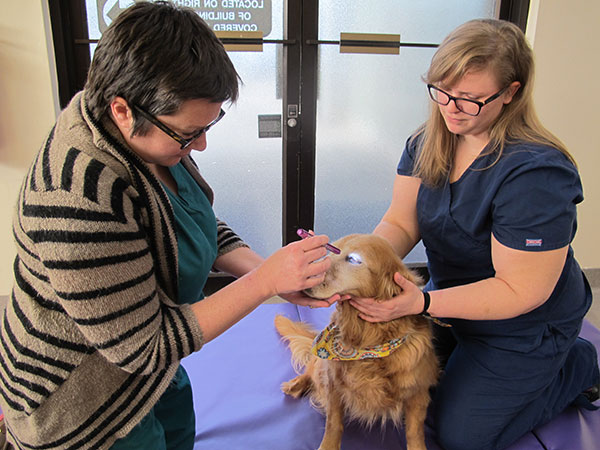The neurologic examination is a specialized physical examination. A neuro exam is performed once a neurologic abnormality is identified by you or your veterinarian. It is unique because once identified it can reliably pinpoint a neurologic abnormality to a specific location within the nervous system. This is called neuroanatomic localization, and it allows the neurologist to direct their diagnostic efforts on the affected portion of the nervous system. This is important in veterinary medicine because our patients are incapable of voicing their symptoms.
Every patient in the Veterinary Referral Surgical Practice Neurology/Neurosurgery service first receives a complete physical examination. Then, the neurologic examination is performed, which includes the following steps:
Observations
- Mentation This refers to the animal’s state of consciousness or arousal. Healthy animals are bright, alert, and responsive to their owners and veterinary staff. Abnormalities include excessive drowsiness/lethargy and unconsciousness.
- Behavior This refers to the pet’s personality. Although it is completely normal to be a little nervous or anxious at the vet’s office, dogs and cats are typically very interested in their surroundings and people. Abnormalities might include disorientation, unusual aggressiveness or docility, or inappropriate vocalizations.
- Gait The gait analysis is two part. The neurologist pays particular attention to both motor and sensory functions. Motor abnormalities include weakness and paralysis, and sensory abnormalities are called ataxia. An ataxic gait can include paws that knuckle over or cross the midline, a drunken appearance, incessant circling, and any other type of wobbliness.
- Posture Abnormal postures such as a head tilt, a bent back, or rigidly extended limbs can be an indication of neurologic dysfunction.
Hands-on tests
- Cranial nerve exam The neurologist will assess the pet’s motor and sensory function, specific to the face. Additionally, the special senses (vision, hearing, and smell) are evaluated.

- Postural reactions A series of tests including flipping the paw over on its knuckles (proprioceptive placing), inducing the pet to hop on its paw, and asking the patient to wheelbarrow assesses the pet’s sense of where its limbs are in space (proprioception).

- Segmental reflexes Spinal reflexes, such as the patellar or knee-jerk reflex help pinpoint a problem within a specific section of the spinal cord.

- Palpation Because pets cannot tell us if or where they hurt, the neurologist will palpate (examine by touching) the head and spine. A pet in pain will tell the neurologist if something hurts by vocalizing, tensing muscles, or dilating its pupils. The neurologist will also palpate muscles to assess their tone and check for atrophy. If the pet is paralyzed, the neurologist will pinch the patient’s toes to ascertain if a sensation is present or not.
After the examination, you and your neurologist can discuss the best, most personalized course of action for your pet.

